It is a huge honor to display projects in the ThermOWeb booth at the 2016 Quilt Market. Using Moda’s new fabric collection, Manderly, for the projects and Luxe interfacing by Thermoweb takes it over the top.
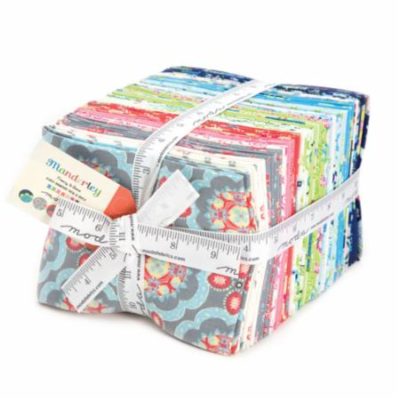
Carla here from Creatin’ in the Sticks to share a quilt made with Luxe interfacing as a foundation and a pillow that can be transformed in moments thanks to reversible butterfly wings and flowers made with Grand Luxe fusible fleece and interfacing. The Luxe brand is quilt shop exclusive and made by ThermOWeb. Ask for it on your next visit to your local quilt shop.
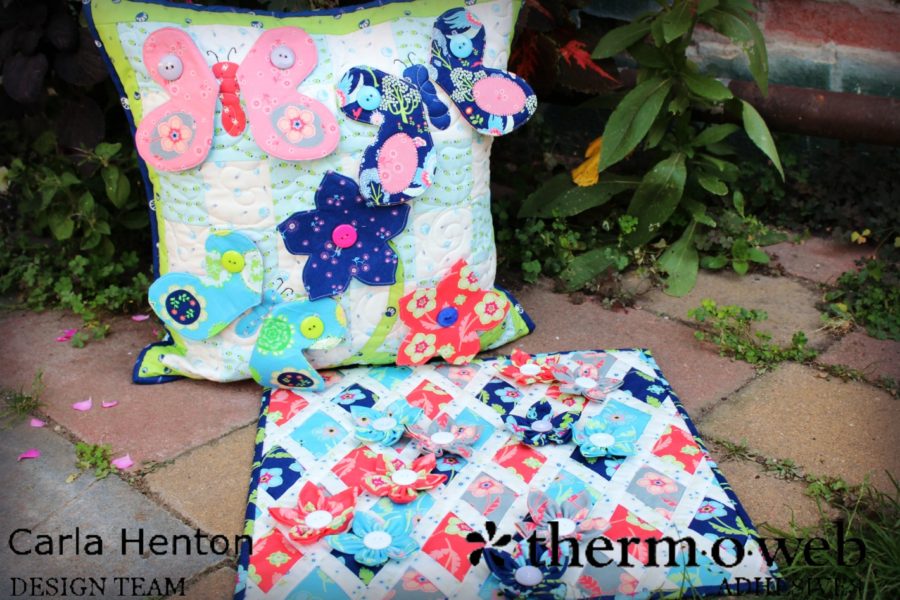
Kanzashi Lattice Mini Quilt
buttons
Iron
permanent marker
60 degree triangle ruler
General sewing supplies: sewing machine, thread, rotary cutter, ruler, scissors, needle, etc.
Fabric:
4 floral fat quarters for diamonds and kanzashi flowers
1 white fat quarter for trellis
binding fabric
backing fabric
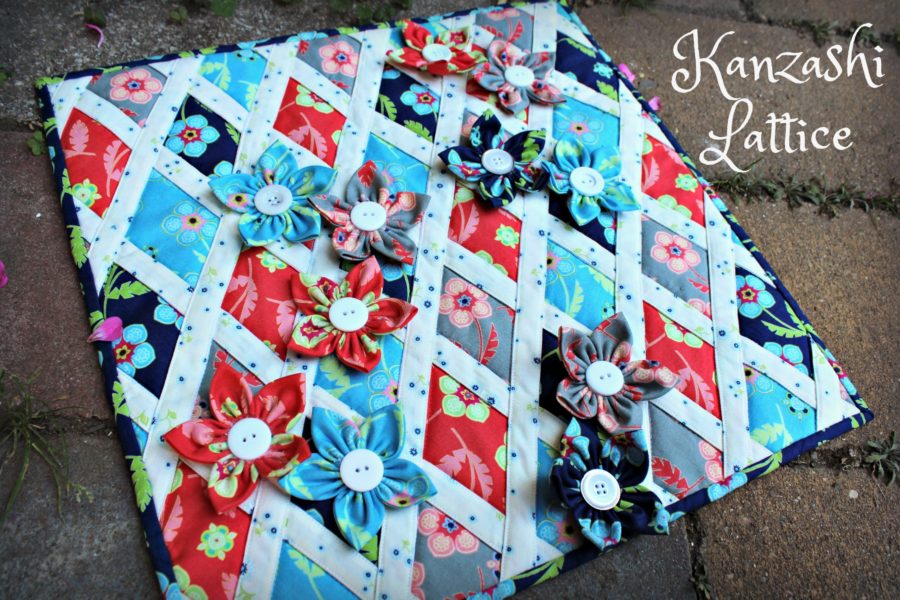
Project Instructions:
The flowers need drying time before they are sewn to the finished quilt so this is the first step. You will need 5 fabric squares, 3″x 3″ for each flower. There is a full tutorial to make the Kanzashi flowers at Creatin’ in the Sticks but here is a condensed version.
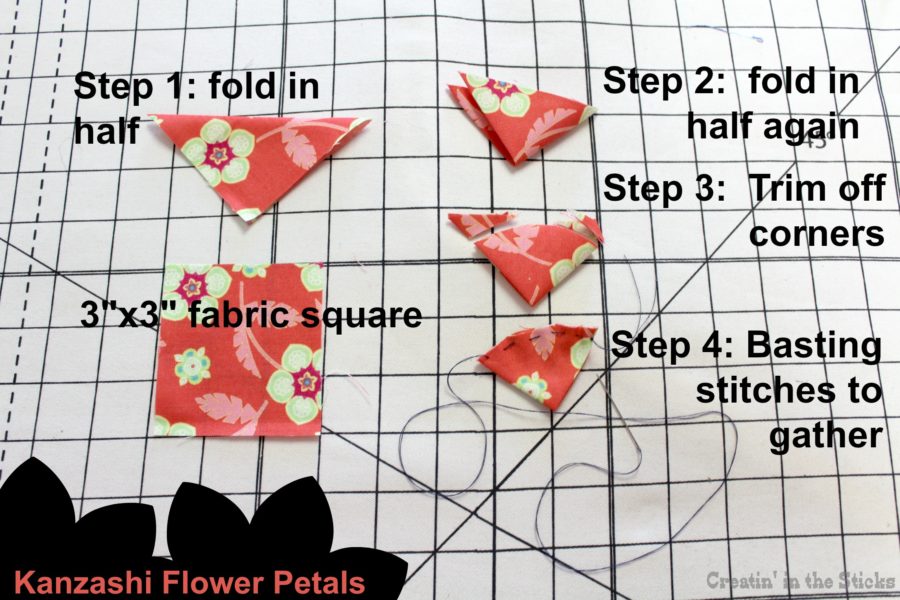
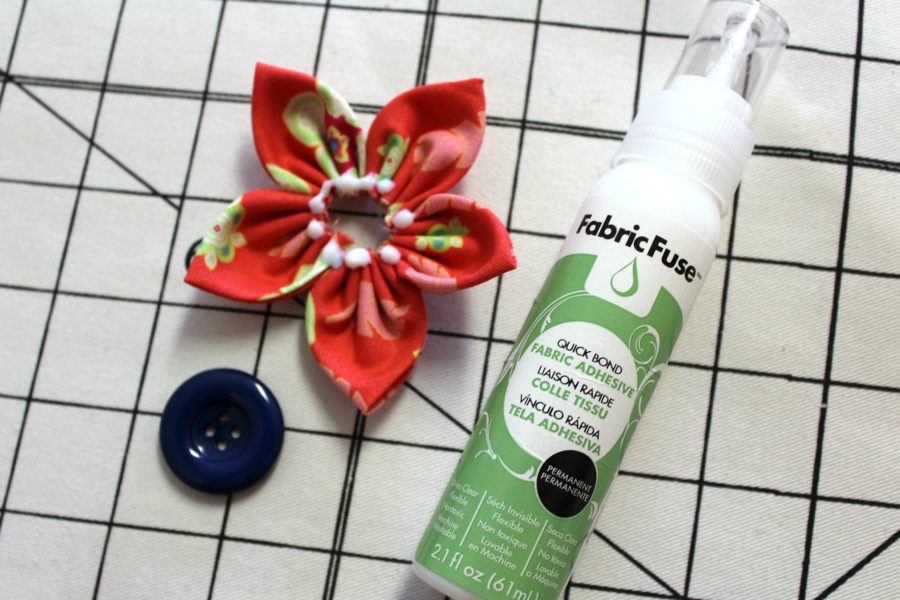
Make as many Kanzashi flowers as you want and set them aside to dry.
Draw the diamond diagram on the feather weight interfacing (non-glue side) with a permanent marker, a 60 degree triangle ruler, and a regular quilting ruler.
Mark one 30 degree line on one corner at the 2 1/2″ mark.
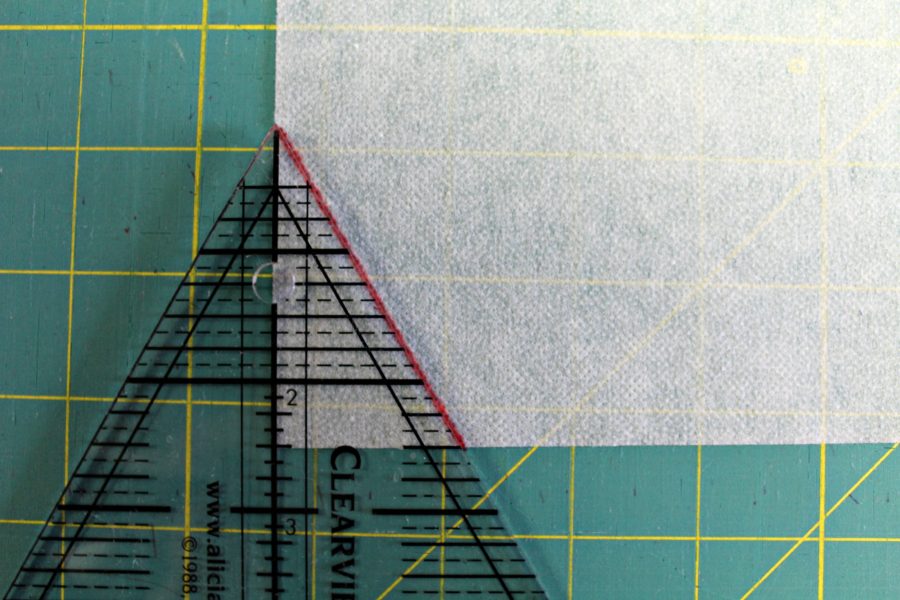
Measure 2 1/2″ form that line and repeat across the interfacing. Next, mark the corner across from the previous start with the same 30 degree line and repeat the lines making the diamond pattern.
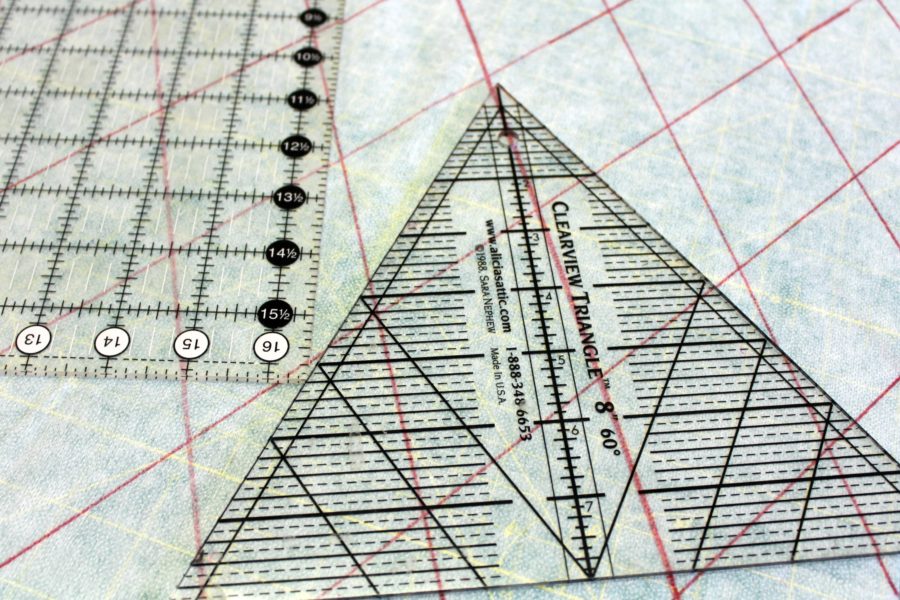
Cut 2 1/2″ strips from the floral fabrics (2 from each color) and cut diamonds. Start by cutting 30 degrees off one end of the strip then measure 2 1/2″ from the cut for the diamond shape.
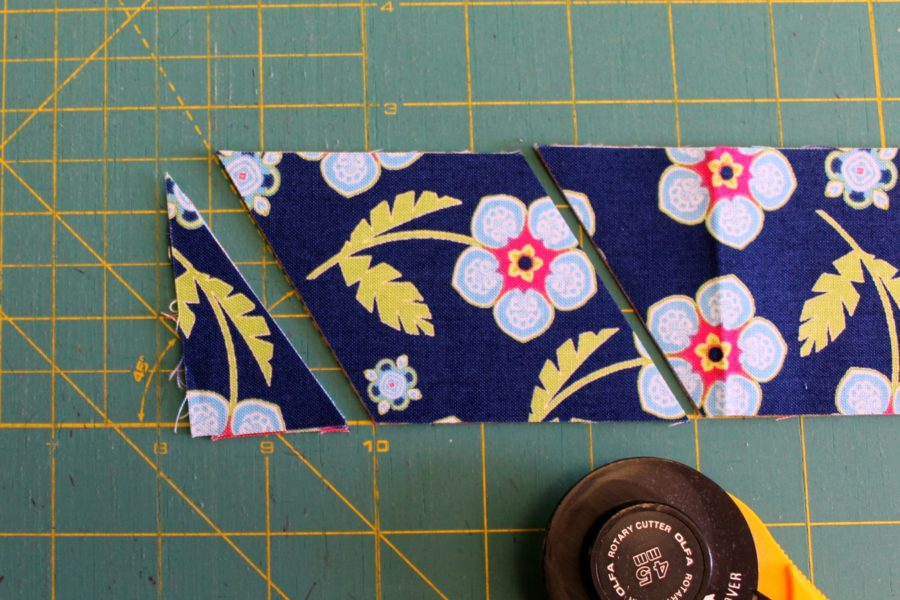
Lay fusible interfacing with the bumpy side up. The drawn lines should be visible from this side too. Place cut diamonds on interfacing with wrong side down on interfacing.
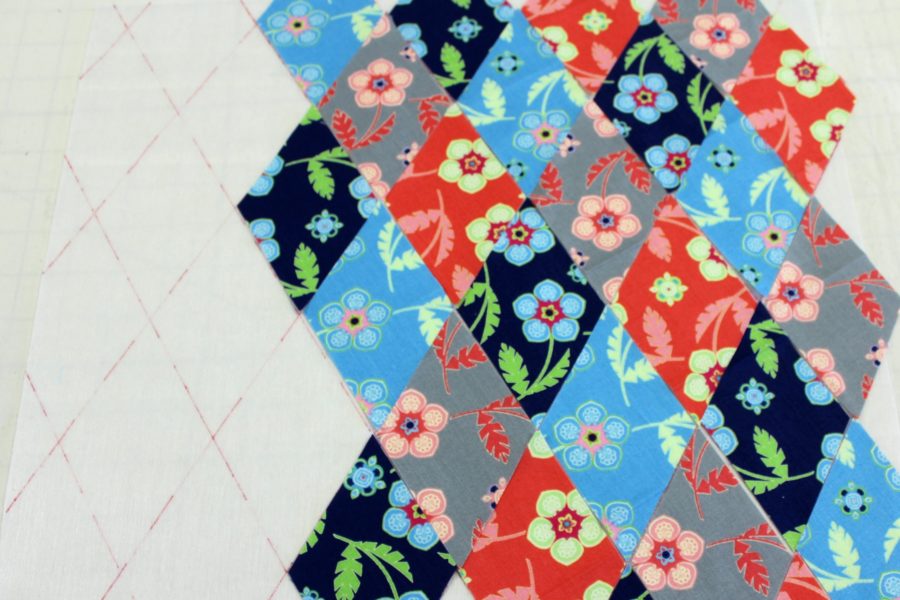
Place all the diamonds on the grid. The outside diamonds will need to be cut (some in half lengthwise and some across) to fill all the holes. Once the grid is filled, bond the fabric to the interfacing by pressing in sections and overlapping as you go.
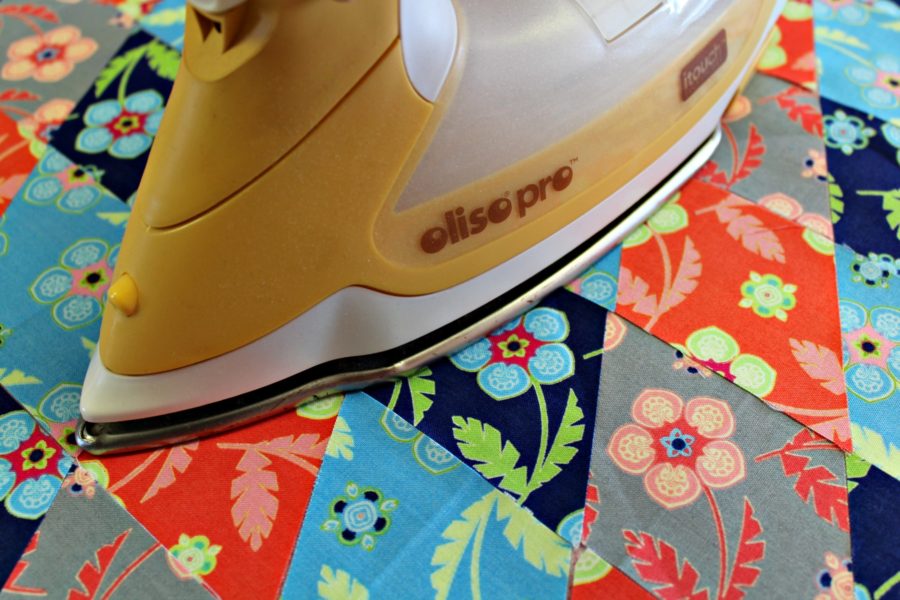
Once the fabric is bonded, turn it over and trim off the loose fabrics. It should be 16 1/2″ x 16 1/2″.
Cut strips from the white fabric and woven interfacing 1 1/4″ x length of the fat quarter (about 20″).
Place one white strip right side against the fusible side of the woven interfacing. Stitch lengthwise and across one end. This is done to make it easier to turn inside out. Turn tubes inside out carefully with your favorite method. A rigid plastic straw and chopstick worked beautifully for this.
Lay strips on lines centering between diamonds going diagonal one way across the quilt with the fuse side down. Tip: A light mist of water on the strips helps to manipulate them Fuse the strips down one at a time taking care to “roll” the edges flat. Edge stitch each strip before starting on the other direction diagonals.
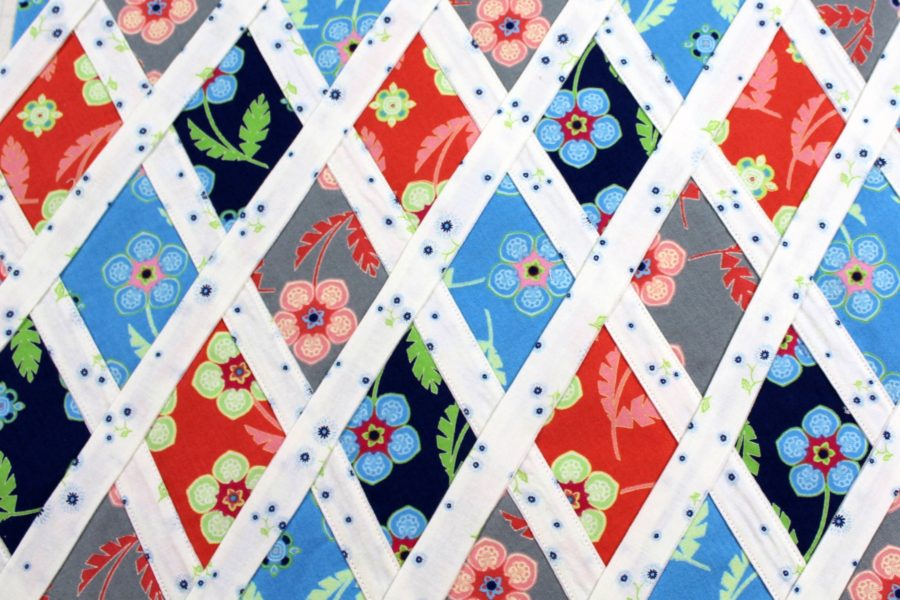
Repeat fusing the other diagonals and fuse down in the same way as before. Finish by edge stitching these strips.
Sandwich the quilt with backing fabric and sewing fleece and quilt as desired. This one was quilted in each diamond. Sew the Kanzashi flowers to the quilt with the buttons and add binding.
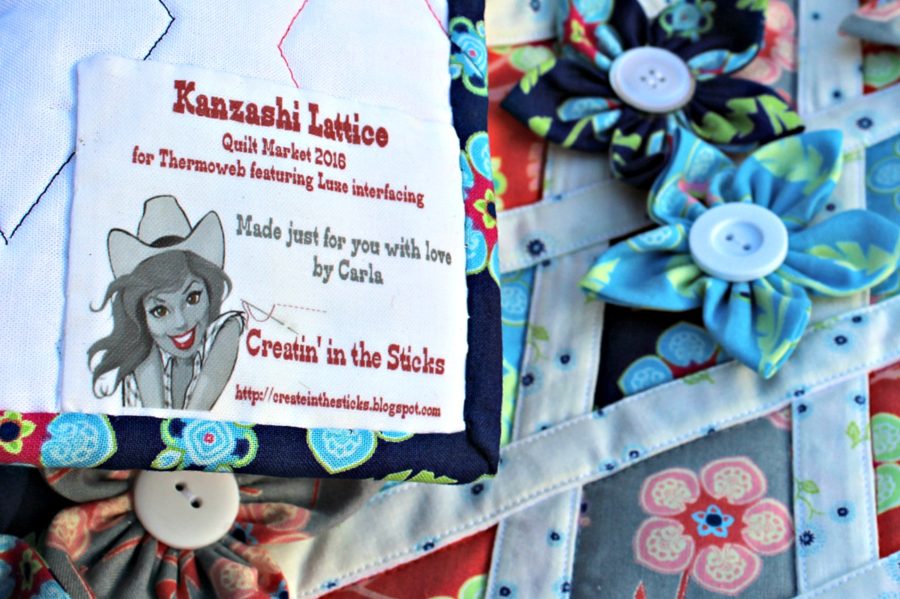
The label was fun to make for this. Use a word program to make the label, print it on HeatnBond EZ Print Inkjet Transfer Sheets, fuse it to fabric, and add it to the back of your quilt.
Learn to Button Reversible Applique Pillow Cover
Not only does this pillow cover help with learning to button, it can change and be a totally different color with the switch of a couple of wings or flowers.
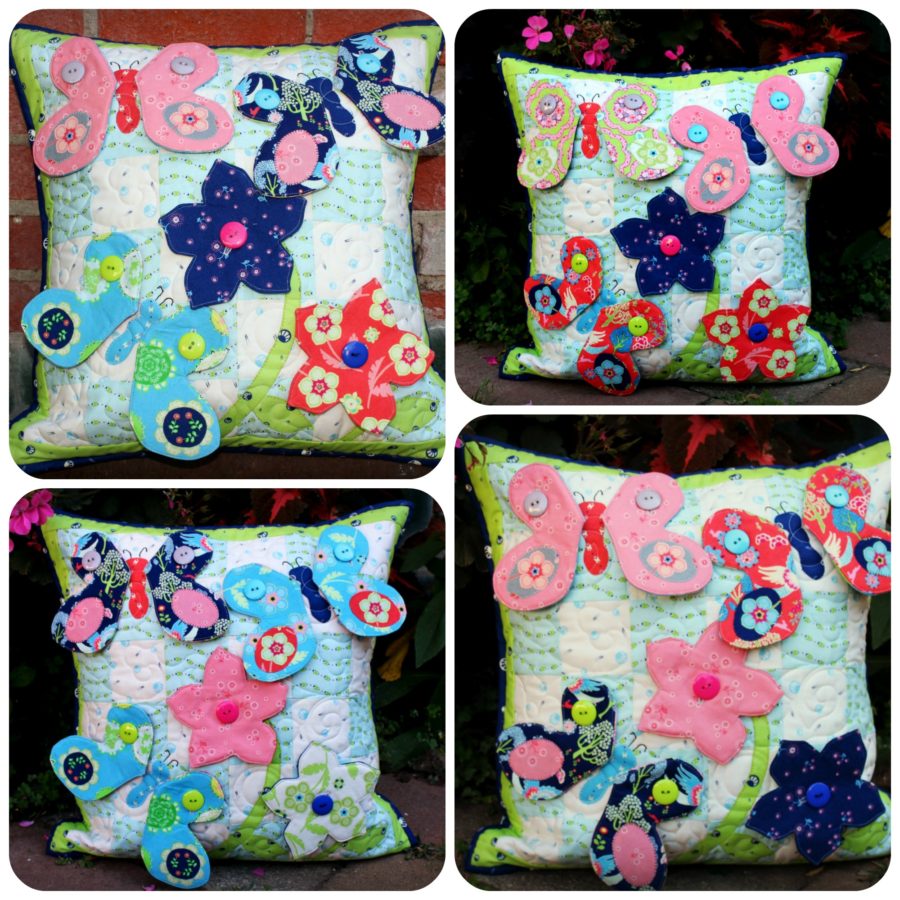
Supplies:
Luxe – Allure extra firm non woven fusible interfacing
8 buttons
16″ pillow form
permanent marker
erasable fabric marker
General sewing supplies: sewing machine, thread, rotary cutter, ruler, scissors, needle, etc.
Fabric:
18 blue patches 3 1/8″ x 3 1/8″
18 white patches 3 1/8″ x 3 1/8″
2 green strips 1 1/2″ x 16 1/2″
2 green strips 1 1/2″ x 18 1/2″
backing for pillow top (won’t be seen) like muslin 18 1/2″ x 18 1/2″
3 different colors for butterfly bodies – 2″ x 3 1/4″
6 different colors for butterfly wings – 9″ x 6 1/2″
6 different colors for spots on wings – 3″ x 4″
4 different colors for flowers – 6″ x 6″
2 -pillow cover backing fabric 11″ x 18 1/2″
binding fabric
Instructions:
Making background:
Piece the background with the 3 1/8″ blue and white squares.
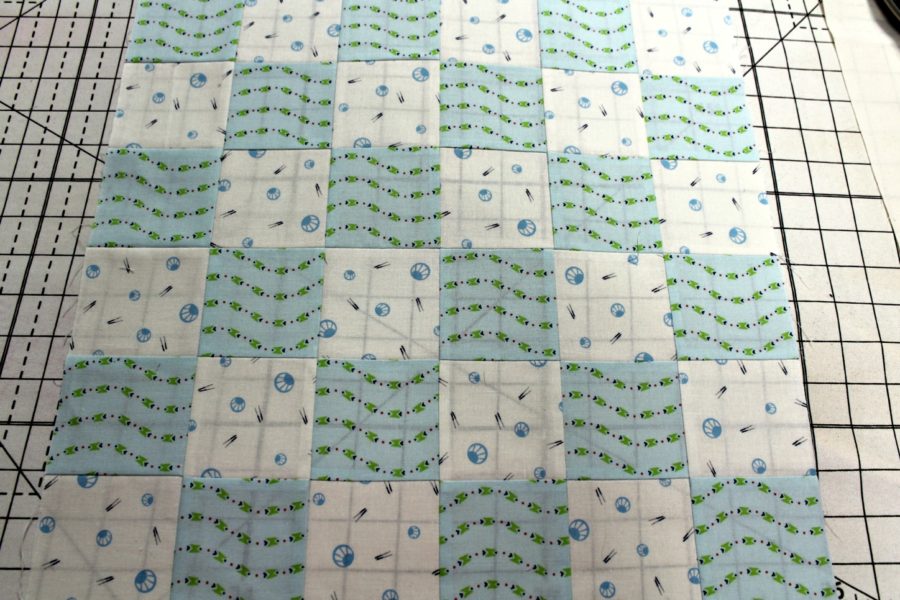
Draw stems and leaves on to the back of Heat n Bond lite and fuse to green fabric. Cut them out and arrange them of the background. Draw butterfly bodies on Heat n Bond lite, fuse it to different fabric scraps, cut out, and fuse the stems, leaves and butterfly bodies to the background. Stitch around each of the with a zigzag, blanket or straight stitch. Add the green sashing strips, sandwich the pillow top with sew in fleece and muslin, and quilt as desired.
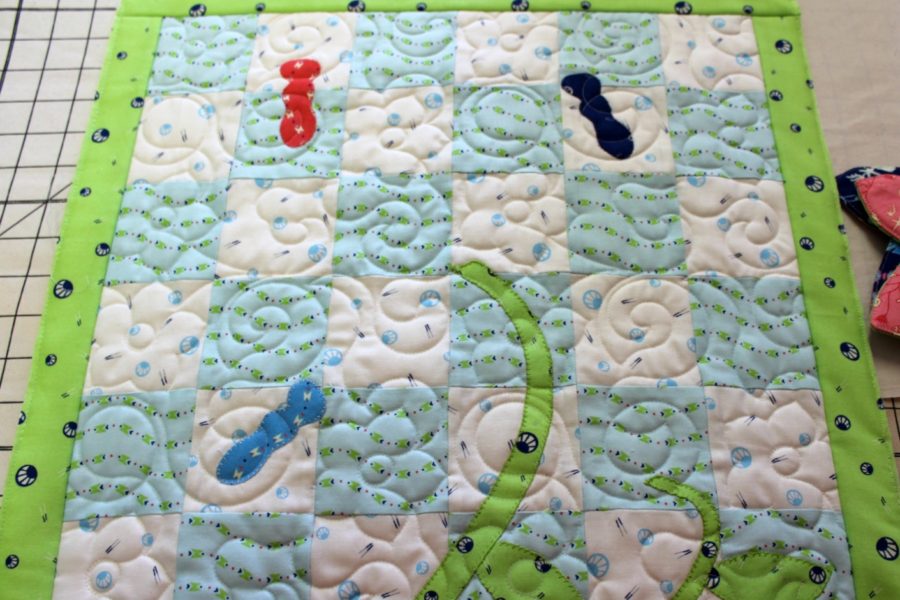
Making wings:
Cut 3 pieces of Luxe – Allure extra firm non woven fusible interfacing 9″ x 6 1/2″ and draw butterfly wings with a permanent marker on the back (smooth side).
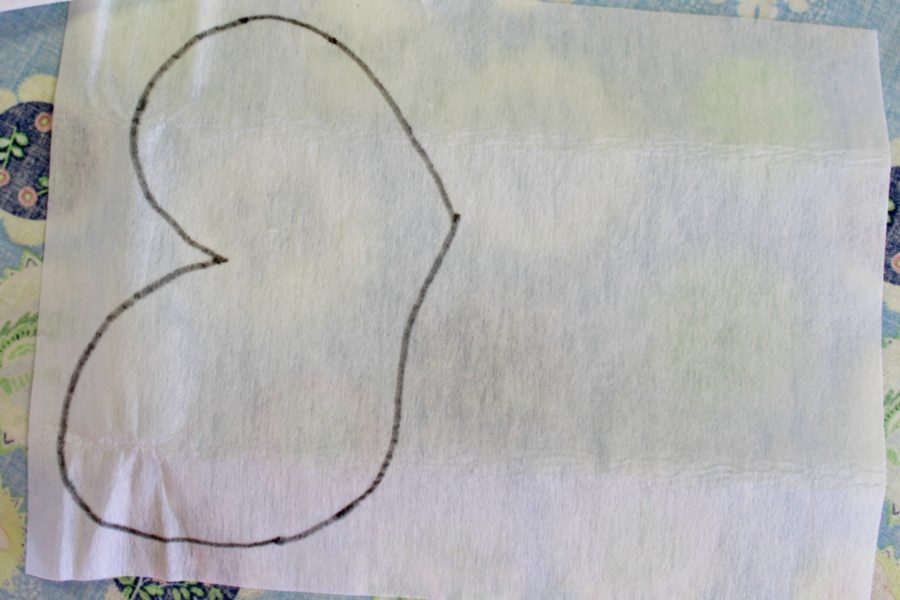
Fuse these 3 pieces to 3 different fabrics then cut 3 pieces of Grand Luxe fusible fleece 9″ x 6 1/2″ and fuse these to the wrong side of the 3 remaining pieces of wing fabric. Pin one interfacing fabric to one fleece fabric, right sides together. Cut the wings out. Now draw 12 spots for the bottom of the wings onto the smooth side of Heat n Bond lite. Fuse the spots to 6 different fabrics, cut out, fuse to the wings, and stitch around each spot. Pin wings together once again pinning one interfacing backed wing to one fleece backed wing and stitch 1/4″ seam around each, leaving an opening to turn it right side out. Clip curves and turn right side out. Close the opening by slip stitching then top stitch around each wing. Sew button holes in the top portion of the wings. Make 6 wings.
Making Flowers:
Cut 2 interfacing pieces 6″ x 6″ and draw a flower on both. Fuse these 2 pieces to the wrong side of 2 of the flower fabrics. Cut 2 fusible fleece 6″ x 6″ and fuse these to the other flower fabric pieces. Pin one interfacing piece to one fleece backed piece with right sides together. With the interfacing side up, stitch on the drawn flower line leaving an opening for turning right side out.
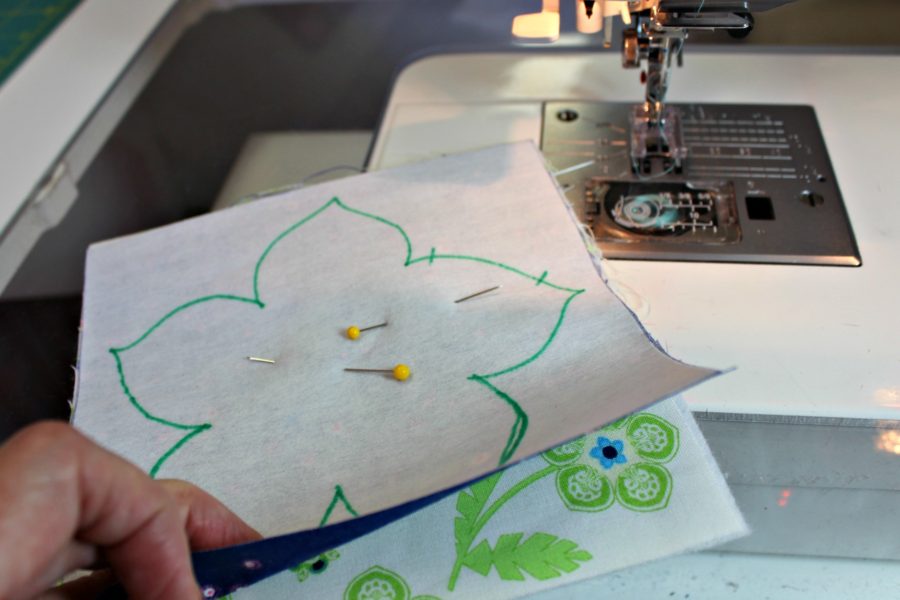
Trim around flower about 1/8″ and gently turn right side out. Close the opening by slip stitching then top stitch around both flowers. Sew button holes in the middle of both flowers.
Finishing Pillow Cover:
Position the wings and flowers on the pillow top for placement and mark the spots for the buttons with an erasable fabric marker through the button holes. Remove wings and flowers and sew buttons onto pillow top.
Hem one 18 1/2″ side of each one of the 2 – 11″ x 18 1/2″ pillow backing fabrics with a narrow hem. Pin pieces to back of pillow top right sides up and overlapping hes in the middle.
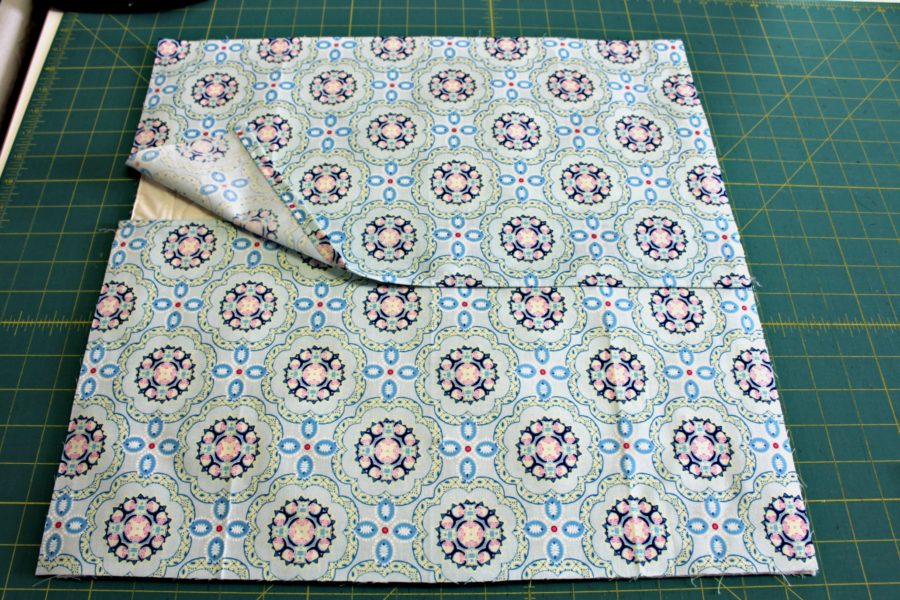
Baste to pillow top all around. The pillow is ready for binding. Bind and have fun with your reversible applique pillow.
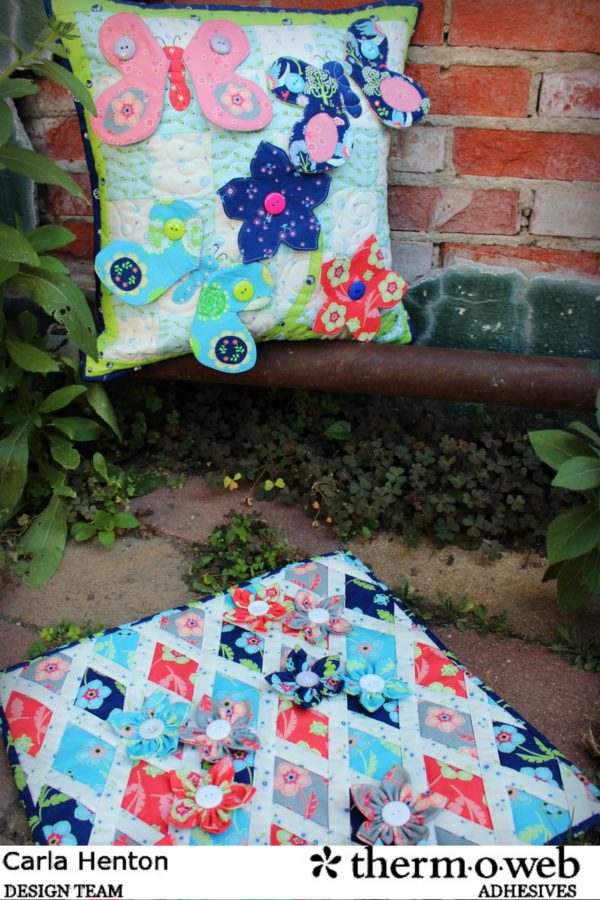
The opportunity to share these projects with you is a blessing. Please ask if you have any questions.
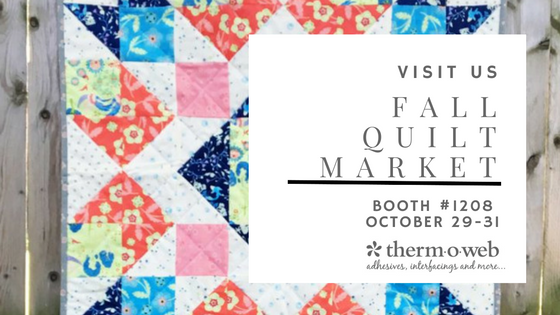

Patricia Cash
November 1, 2016 at 7:37 am (9 years ago)Love the pillow, thanks.
QuiltShop Gal
November 1, 2016 at 8:43 am (9 years ago)Super cute projects and great tutorials.
QuiltShopGal
http://www.quiltshopgal.com